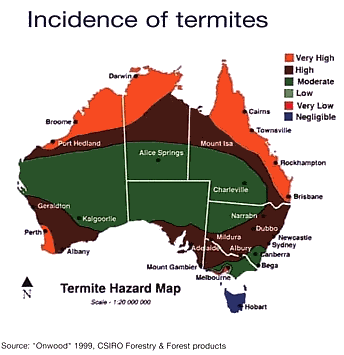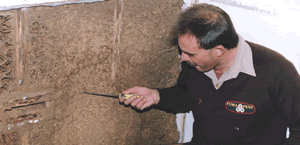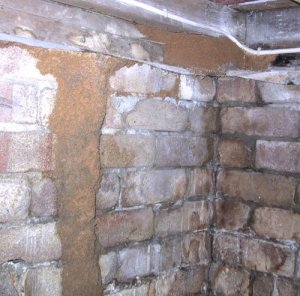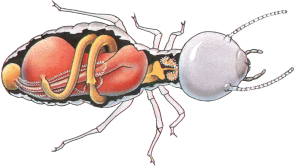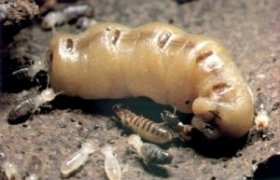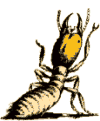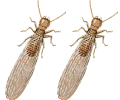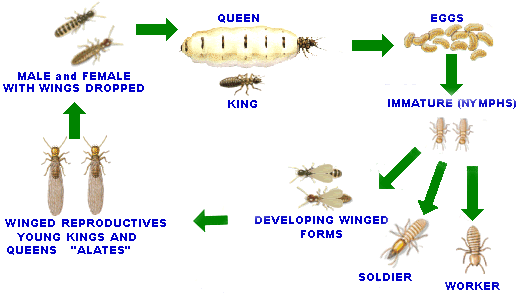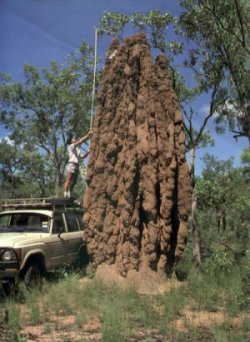It is essential for the subterranean termite pest controller to properly
identify the species of subterranean termite found in a property. Some species
of white ants prefer living and will not attack dry seasoned timbers in
a building, whilst others can be are highly destructive to such buildings
in a short amount of time.
Coptotermes acinaciformis
Commonly found throughout Australia - particularly in urban areas or where
eucalypt gum trees are highly prevalent.
Nest Location - Coptotermes acinaciformis are a very secretive white
ant species; they build their nest out of sight, often within the base of
eucalyptus or other susceptible trees, or completely under the ground; often
within an enclosed patio or under concrete on ground flooring which is ideal
for moisture retention, temperature and humidity control within the white
ant colony's central nest. Coptotermes acinaciformis can also construct
subsidiary subterranean termite nests away from the main colony nest. A
subsidiary subterranean termite nest can be contained in a wall cavity of
a building where there is a reliable moisture source, for example, from
a leaking shower recess or faulty guttering or rusted down pipes.
Destructive Nature - Coptotermes acinaciformis are highly destructive
to buildings and other timber structures. They are the most widely distributed
and destructive timber pest in Australia, accounting for more than 70% of
the serious damage to buildings in Australia. A single colony may consist
of more than one million white ants. A most voracious timber pest ... one
to be taken seriously.
Mastotermes darwiniensis
Area of Distribution: Commonly found in tropical Queensland, Northern Territory
and Western Australia - generally north of the tropic of Capricorn.
Nest location - Mastotermes darwiniensis build their nest (secretively)
totally below the soil surface; or in the trunks and root crowns of trees
and stumps. Once a nest is mature (over 100,000 or much higher) they can
'split off' to form other nests over a wide ranging area. These sub nests
are formed constantly and can sustain life for along period of time without
contact to the original nest.
Destructive nature - Mastotermes darwiniensis is one of the world's
most destructive white ant species, often causing severe damage to houses,
buildings, bridges, posts, poles, and many other plant and animal products.
It is also an agricultural pest, responsible for ringbarking and killing
living trees, shrubs, fruit, vegetable crops, sugarcane and rubber trees.
It is reported to attack rubber tyres on tractors and cause damage to
leather, hide, plastic or lead-sheathed cables, bitumen, bagged salt,
flour, glass and various metals. Mastotermes darwiniensis is the
most ancient of all the white ants in the world - they occur only in
Australia - a white ant to be feared.
Schedorhinotermes intermedius
Area of Distribution: Commonly found in eastern NSW and south eastern Queensland
- particularly along the entire coast-line, the Great Dividing Range and
adjoining slopes.
Nest Location - Schedorhinotermes intermedius commonly build their
nest in tree stumps, in the root crown of the living, dead and debilitated
trees, under houses or within enclosed patios or other areas where timber
has been buried or stored in contact with the soil.
Identification - this species tends to "gouge" the affected timber and has
a fetish around nails used in construction. When you first find them, you
will often see a major soldier (6mm in body length) and a minor soldier
(4mm in body length).
Destructive Nature -Schedorhinotermes intermedius are highly destructive
to buildings and other timber structures. If mostly major (larger) soldiers
are sighted, then they will most likely be a large colony with the potential
to cause severe and rapid damage to structural timbers of a building or
other timber structures.
Coptotermes frenchi
Area of Distribution: Commonly found throughout NSW, ACT, Victoria and south
eastern South Australia; particularly in urban areas, where buildings are
constructed of softwood or oregon timber framing. This species is responsible
for most of the timber pest damage to buildings in the ACT region.
Nest Location - Coptotermes frenchi most often build their nest in
the root crown or lower trunk area of living trees, particularly eucalypts.
They may also build their nest as a mound in the dryer areas.
Destructive Nature - Coptotermes frenchi can cause severe damage
to buildings and other wooden structures. It is common for this species
to devour timber framing leaving only a thin veneer. This species is the
most shy of the destructive species; they will retreat from a location immediately
(for the time being) if disturbed.
Nasutitermes exitiosus
Area of Distribution: Commonly found throughout NSW, ACT, Victoria and the
southern areas of Queensland and Western Australia - particularly in urban
areas or where eucalypt gum trees are highly prevalent.
Nest Location - Nasutitermes exitiosus build a mound nest which
protrudes 30cm to 75cm above the ground. Control can be as easy as knocking
the top off the nest and a follow up insecticide treatment inside the nest.
Destructive Nature - Nasutitermes exitiosus are destructive to buildings
and other timber structures. Sometimes severe damage may occur, but not
so commonly as the other species listed above.
Coptotermes lacteus
Area of Distribution: Commonly found in eastern NSW, the ACT, and the south
eastern areas of Queensland including Brisbane and coastal region to Rockhampton
- particularly prevalent along the entire coast-line, along the Great Dividing
Range and western slopes.
Nest Location - this white ant species, most often builds it's nest as a
mound up to 2m above ground level, with hard clay walls, so control is easily
effected once located by knocking the top off and insecticide treatment
of the nest.
Destructive Nature - Coptotermes lacteus attacks stumps, dead trees,
timber fences, poles and other timber structures that are in contact with
the soil, being softened by weathering or decay. These white ants are also
known to attack such timber in damp sub-floor areas.
Nasutitermes walkeri
Area of Distribution: Commonly found in eastern NSW and south eastern Queensland
- particularly prevalent in the coastal and mountain regions along the entire
eastern side of NSW.
Nest Location - Nasutitermes walkeri build their nest in trees on
the main trunk or in the fork of a large branch.
Destructive Nature - Nasutitermes walkeri can be destructive to damp
timbers often a serious problem where the sub-floor of a building is damp
and ventilation is poor with resulting wood decay or fungal growth.
Heterotermes ferox
Area of Distribution: Commonly found throughout NSW, the ACT, Victoria,
and southern parts of South Australia and Western Australia - particularly
in urban areas or where eucalypt gum trees are highly prevalent.
Nest Location - Heterotermes ferox often build their colony nest
next to stumps, logs, or other timber in direct contact with the soil where
some wood decay or rotting is prevalent.
Destructive Nature - Heterotermes ferox are be destructive to damp
timbers and are usually found attacking fences, poles and other timber structures
subject to wood decay from weathering or from being in contact with the
soil. This species is often confused with the more aggressive and destructive
Coptotermes acinaciformis species. Correct identification is essential.
Dampwood termites - form small independent nests which often attack sick
or dead trees, decaying stumps or mouldy timber in the ground; they are
seldom found in dry timbers in buildings.
Drywood termites - occur mostly in tropical areas, where the atmospheric
humidity is constantly above 75 percent. The introduced and highly destructive
West Indian drywood white ant, Cryptotermes brevis, is rarely located
in NSW, once in Sydney in the early 1980's. Specialist eradication procedures
involve wrapping the entire building in plastic and using methyl bromide
fumigation.
|
